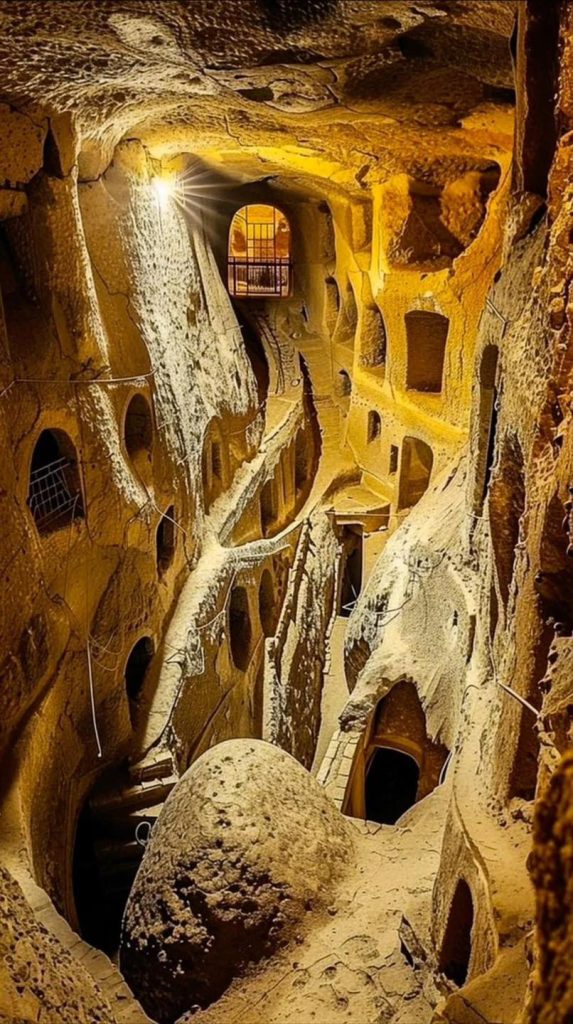Archaeologists have recently unearthed compelling evidence pointing to the existence of an extensive network of underground tunnels that spans across Europe, stretching from Scotland all the way to Turkey. Dating back approximately 12,000 years, these subterranean passages may hold the key to understanding how interconnected ancient civilizations really were. This groundbreaking discovery offers new insight into prehistoric Europe, challenging long-standing assumptions about how early societies lived, communicated, and traveled.

Despite the vastness of this network, the exact purpose behind the creation of these tunnels remains a matter of speculation. However, archaeologists and historians have developed several leading theories based on physical evidence, location, and the cultural context in which these tunnels were built. Some researchers believe that the tunnels served as a means of protection, offering early humans a safe passage during times of danger—possibly from predators, invaders, or harsh weather. Others suggest that these tunnels functioned as ancient highways, allowing people to travel long distances underground for purposes of trade, migration, or communication. There is also a possibility that these tunnels carried spiritual or ceremonial significance, serving as symbolic or sacred pathways connected to religious rituals or mythologies.
One of the leading voices in this area of research is German archaeologist Dr. Heinrich Kush. He has thoroughly documented these findings in his influential book, Secrets Of The Underground Door To An Ancient World. According to Dr. Kush, thousands of tunnel entrances have been discovered underneath Neolithic settlements across Europe, suggesting a widespread and coordinated effort among early human communities to create this underground infrastructure. This, in turn, implies a higher level of organization, shared knowledge, and possibly even collaboration among various prehistoric societies.
The construction of these tunnels is a marvel in itself. Varying in size, many of the tunnels are large enough for a person to walk through upright, with some exceeding a meter in width. These are not simple burrows or makeshift hideaways—they are sophisticated structures, often including multiple chambers, storage spaces, and even carved seating areas or small niches. The quality of craftsmanship suggests that the builders possessed advanced engineering skills, as they were able to construct stable passageways and underground rooms in a variety of terrains. These tunnels also show evidence of strategic planning, possibly designed to connect key locations across vast distances while maintaining structural integrity and safety.
Among the most notable examples of this ancient underground architecture is the city of Derinkuyu in Cappadocia, Turkey. Built into soft volcanic stone, Derinkuyu is a sprawling multi-level underground city that could once house thousands of people. It features ventilation shafts, water wells, storage areas, and even stables for animals. This remarkable site stands as a testament to the ingenuity and architectural knowledge of its creators. The fact that such a complex structure could be built without modern tools continues to fascinate experts to this day.
Another significant site is located in Bosnia, where the so-called Bosnian Pyramids and their associated tunnel systems have generated international interest. These tunnels, which extend beneath the surrounding hills, display a level of engineering that some experts argue rivals that of ancient Egypt. Supporters of this theory point to the uniformity of the tunnel walls, the use of megalithic blocks, and the presence of air-flow channels that suggest intentional and skillful design. While debate continues over the true origins of the Bosnian Pyramids, the tunnels themselves offer undeniable proof of advanced construction methods in prehistoric Europe.
There is also a cultural and perhaps even religious aspect to these tunnels that has intrigued researchers. Dr. Kush has proposed that during the rise of Christianity in Europe, churches were deliberately built over the entrances of these tunnels. This strategic placement may have been intended to control access to the subterranean world and limit knowledge about these ancient networks. In some areas, inscriptions have been found within the tunnels referring to them as “gateways to the underworld.” These references raise the possibility that the tunnels were not merely practical in nature but also carried symbolic or ritualistic significance. In ancient cultures, the underworld was often associated with the spiritual realm, the afterlife, or the domain of the gods, suggesting that these tunnels may have played a role in early religious beliefs and ceremonies.
The implications of this discovery are profound and far-reaching. The existence of a continent-wide tunnel system built over 12,000 years ago challenges many modern assumptions about prehistoric humans. Traditionally, early societies in Europe have been portrayed as primitive, isolated, and lacking in technological development. However, the complexity and scale of these tunnels tell a very different story. They suggest that early humans possessed not only the intellectual capacity but also the organizational structure necessary to undertake such monumental projects. This network of tunnels may represent one of the earliest known examples of interconnectivity between human settlements on a large scale, long before the rise of known civilizations like Mesopotamia or Egypt.
Moreover, this discovery compels scholars to rethink the timeline and progression of human development. If people living 12,000 years ago were capable of constructing such intricate underground systems, it raises questions about what other achievements they may have accomplished that have since been lost to history. Could these tunnels be just one piece of a much larger puzzle—a forgotten chapter in the story of human civilization?
In light of these findings, many researchers are calling for further excavation and interdisciplinary studies to fully explore the scope and meaning of these ancient tunnels. Whether used for travel, protection, or spiritual practices, they offer an extraordinary glimpse into the minds and lives of our ancestors. The more we uncover, the more we come to appreciate the depth and sophistication of ancient cultures that once thrived across Europe. These tunnels are more than just passages beneath the earth—they are portals into humanity’s distant past, waiting to tell their stories to those who are willing to listen.





